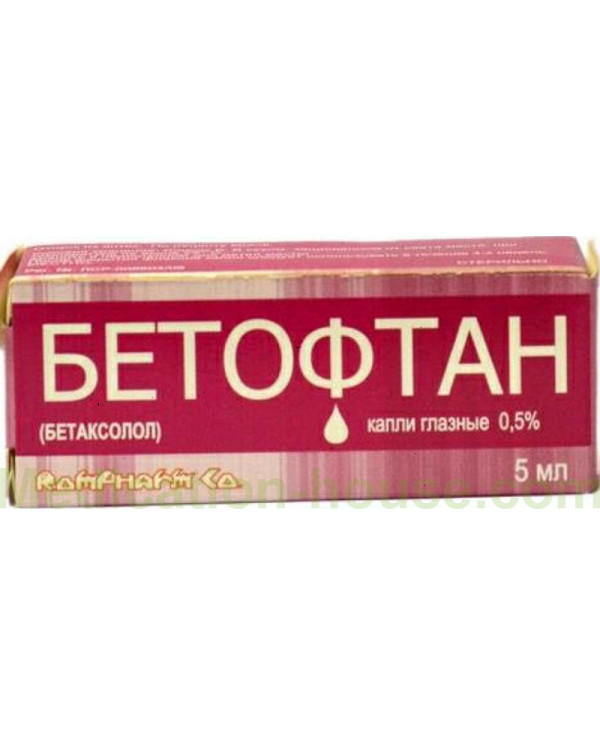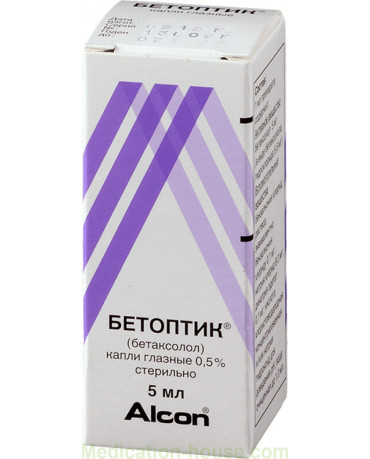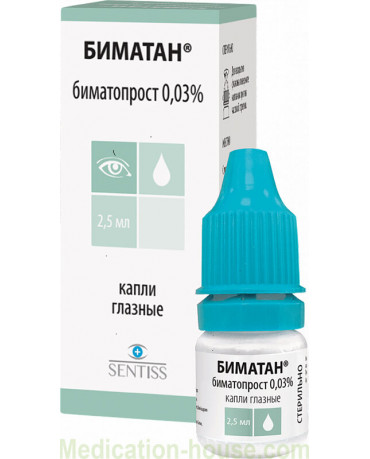Instruction for Betoftan
You can buy Betoftan on this page
Betoftan is a beta-blocker, antiglaucoma agent.
Release form and composition
Dosage form - eye drops 0.5%: colorless or light yellow with a brown tint, a solution with a transparent structure (5 ml each in a polymer dropper bottle, in a cardboard box 1 bottle).
1 ml of solution contains:
active substance: betaxolol (in the form of hydrochloride) - 5 mg;
auxiliary components: sodium chloride, sodium hydrogen phosphate dodecahydrate, benzalkonium chloride, sodium dihydrogen phosphate monohydrate, disodium edetate dihydrate, purified water.
Indications for use
chronic open-angle glaucoma;
ocular hypertension;
angle-closure glaucoma (as part of combination therapy with miotics).
Contraindications
atrioventricular (AV) block II and III degree;
sinus bradycardia;
sick sinus syndrome (SSS);
age up to 18 years;
hypersensitivity to the components of the drug.
It is recommended to use Betoftan with caution in patients with diabetes mellitus, with pheochromocytoma, thyrotoxicosis, bronchial asthma, chronic obstructive bronchitis, heart failure, grade I AV block, Raynaud's syndrome, while prescribing oral beta-blockers.
During pregnancy and breastfeeding, the use of the drug is possible if the expected benefit of therapy for the mother, in the opinion of the doctor, outweighs the potential threat to the fetus or child.
Method of administration and dosage
Drops Betoftan are instilled into the conjunctival sac.
The doctor prescribes the dose and treatment period.
Recommended dosage: 1-2 drops, 2 times a day.
Since the stabilization of intraocular pressure can occur within several weeks, it is recommended to monitor the intraocular pressure regularly during the first four weeks of therapy.
If, against the background of monotherapy with Betoftan, it is not possible to achieve the desired level of intraocular pressure, additional therapy is required.
Side effects
local reactions: lacrimation, transient sensation of discomfort in the eyes after instillation; in some cases - keratitis, decreased sensitivity of the cornea, photophobia, redness of the eyes, blurred vision, anisocoria, feeling of dry eyes, itching, allergic reactions;
cardiovascular system: impaired cardiac conduction, heart failure, bradycardia;
nervous system: nausea, headache, drowsiness, dizziness, insomnia, increased symptoms of myasthenia gravis, depression;
respiratory system: bronchospasm, dyspnea, respiratory failure, bronchial asthma.
The development of systemic side effects occurs in rare cases.
Special instructions
Patients who wear contact lenses are advised to remove them before instillation and replace them 20 minutes after the procedure. This will avoid damaging the eye tissue of benzalkonium chloride.
Do not allow the pipette to come into contact with any objects, including eyes.
Since beta-blockers can mask the symptoms of acute hypoglycemia, the drug should be prescribed with caution in patients prone to hypoglycemia.
In addition, beta-blockers can mask tachycardia and other symptoms of hyperthyroidism. If you suspect thyrotoxicosis, the drug should not be abruptly canceled so as not to cause an increase in symptoms.
When carrying out a planned operation, it is necessary to gradually stop using beta-blockers, no later than 48 hours before general anesthesia.
With instillation, Betoftan can enter the system of the systemic circulation and cause side effects similar to those that appear with intravenous or parenteral use of beta-blockers.
Although the drops have a minimal effect on blood pressure (BP) and heart rate (HR), care must be taken when treating patients with heart failure or grade I AV block. In case of signs of decompensation of the cardiovascular system, the drug should be canceled.
During the period of treatment with Betoftan, it is not recommended to engage in driving vehicles and mechanisms, since the action of drops can temporarily reduce the clarity of vision.
Drug interactions
With the simultaneous use of Betoftan:
adrenaline solution (for use in ophthalmology) in some cases can cause the development of mydriasis;
reserpine and other drugs that deplete catecholamines increase the risk of increased effects such as bradycardia and lowering blood pressure;
sympathomimetics enhance their vasoconstrictor effect;
beta-blockers for oral administration, as a result of an additive effect, increase the likelihood of developing local and systemic side effects;
muscle relaxants, adrenergic psychotropic and hypoglycemic agents can enhance their effect.
If it is necessary to simultaneously prescribe other local ophthalmic drugs, the interval between treatment procedures should be 10 minutes or more.
Terms and conditions of storage
Keep out of the reach of children.
Store in a place protected from light and moisture at temperatures up to 25 ° C.
The shelf life is 3 years.
After opening the bottle of Betoftan, the drops should be used within a month.
Terms of sell
You can buy Betoftan without a prescription.



